Energy Storage System (ESS) Short Circuit Safety Protection SETsafe | SETfuse Solutions & Products
Overview
Circuit safety protection in Energy Storage Systems (ESS) ensures safe and reliable operation through multi-layered hardware and software measures. These protections address electrical, thermal, and physical safety aspects. In practice, protection schemes should be tailored to system scale, battery type (e.g., lithium or lead-acid), and application scenarios (e.g., residential or industrial storage).
Why Is Safety Protection Against Short Circuits In Energy Storage Systems Necessary
Reason
When a short circuit occurs in an Energy Storage System (ESS), the following phenomena may arise:
Current Surge:
A short circuit leads to a sharp reduction in circuit impedance, instantly generating extremely high short-circuit currents, which can reach tens or even hundreds of times the normal current.
Voltage Drop:
The voltage at the short-circuit point rapidly drops to near zero, potentially causing instability or sag in other parts of the system.
High Temperature and Sparks:
Short-circuit current flowing through conductors or batteries generates significant heat, which can lead to arcs, sparks, or burnt components, and even trigger fires.
Battery Abnormalities:
For battery energy storage systems (e.g., lithium batteries), a short circuit can cause battery overheating, swelling, leakage, or even thermal runaway, potentially leading to fire or explosion in severe cases.
Equipment Damage:
A short circuit can burn out cables, connectors, inverters, or control modules, causing partial or complete system failure.
Protection Device Actuation:
If the system has short-circuit protection mechanisms (such as fuses or circuit breakers), they will quickly actuate upon a short circuit, disconnecting the circuit, possibly accompanied by circuit breaker tripping or fuse melting.
System Alarm or Shutdown:
The energy storage system's monitoring system may detect anomalies, triggering alarm signals or automatic shutdown to prevent further damage.
Smoke or Odor:
Overheating caused by a short circuit can produce a burning smell or smoke, especially when insulation materials or batteries are damaged.
These phenomena occur extremely rapidly (usually in milliseconds), and without effective protection measures, the consequences can quickly escalate, endangering equipment and personnel safety. Therefore, short circuit protection is essential to ensure the safety of equipment and property.
SETsafe | SETfuse Solutions & Products:
Low Voltage Fuses (LV Fuses) are connected in series close to the power source or load, placed in circuits near battery packs, high-voltage boxes (battery clusters), combiner boxes, or critical loads, to quickly isolate faults.
For more information about the product, Learn more
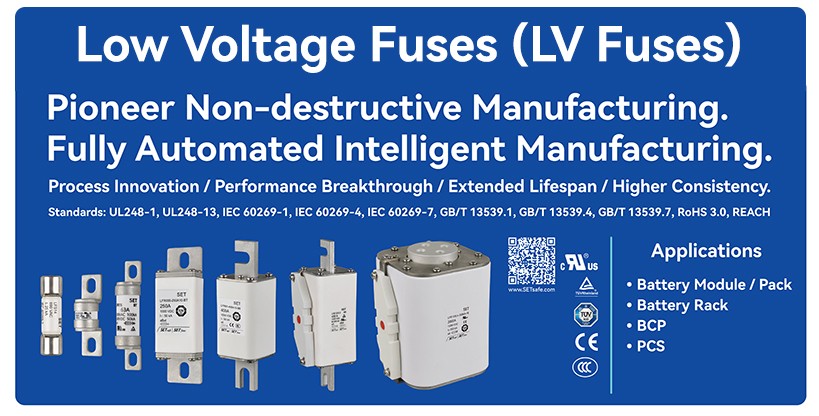
Protection Principle:
Among the many solutions for short-circuit protection, installing fuses in the circuit is common. When the current exceeds a set value, the fuse rapidly melts, disconnecting the circuit and preventing further damage caused by the short circuit. Fuses are a simple, cost-effective, and efficient short-circuit protection solution widely used in energy storage systems.
Low Voltage Fuses (LV Fuses) Working Principle:
When a short circuit occurs in the circuit, the current increases sharply, and the fusible element inside the fuse melts due to overheating, quickly interrupting the circuit and protecting the battery and system from damage.
Advantages of Using Low Voltage Fuses (LV Fuses):
Fast response speed, low cost, simple installation.
High breaking capacity (high current interrupting rating).
High current-limiting characteristics (low I²t value).
Safe and silent operation: When interrupting the maximum short-circuit current, no gas, flame, arc, or other materials are released. Furthermore, the rapid operation when interrupting high short-circuit currents effectively limits the hazard of arc flash.
Superior protection for personnel and equipment during arc flash: When an arc fault occurs, a properly sized current-limiting fuse can interrupt the current within milliseconds in its current-limiting range, effectively keeping the arc energy below dangerous and destructive levels.
Low Voltage Fuses (LV Fuses) Application Scenarios:
Fuses are typically installed in battery modules, high-voltage boxes (battery clusters), combiner boxes, or main circuits as the first line of defense against short circuits and severe overloads.
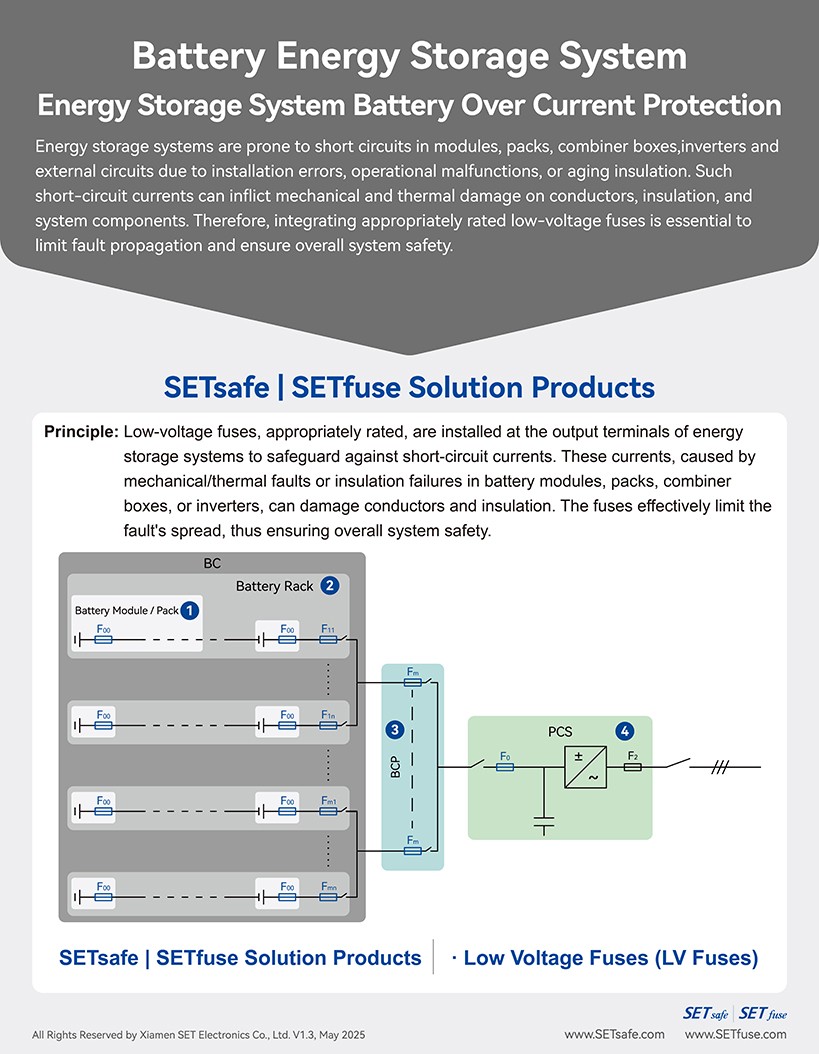
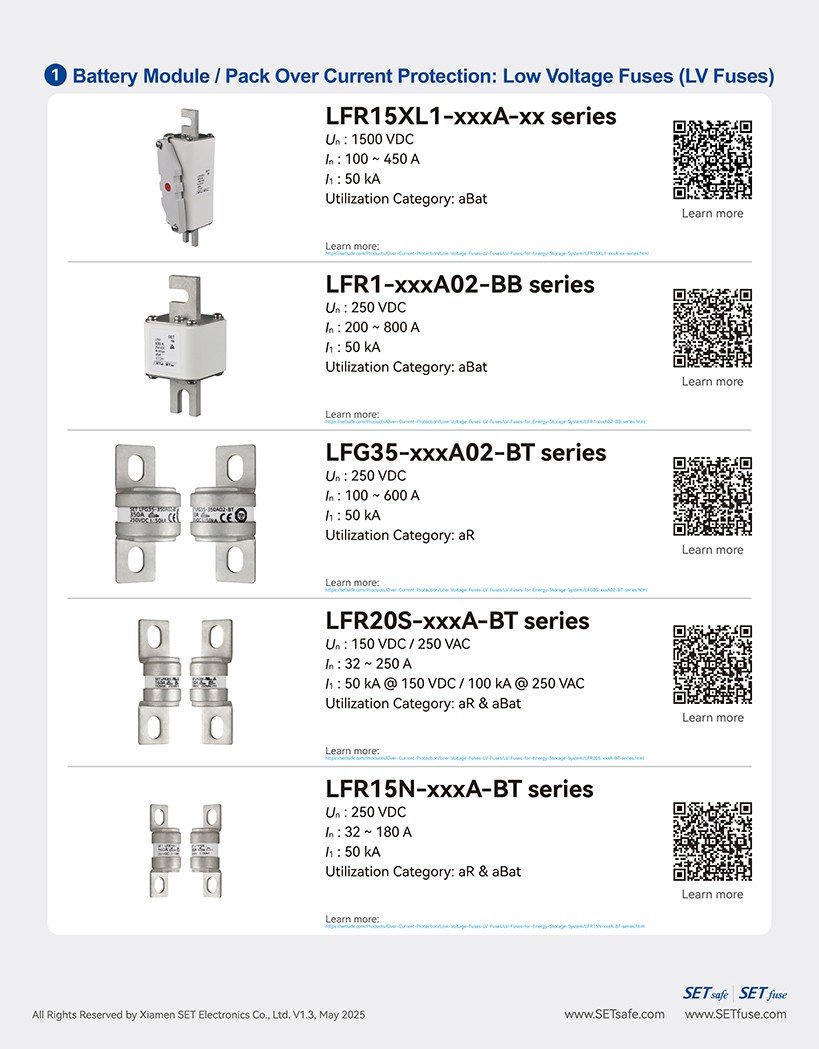
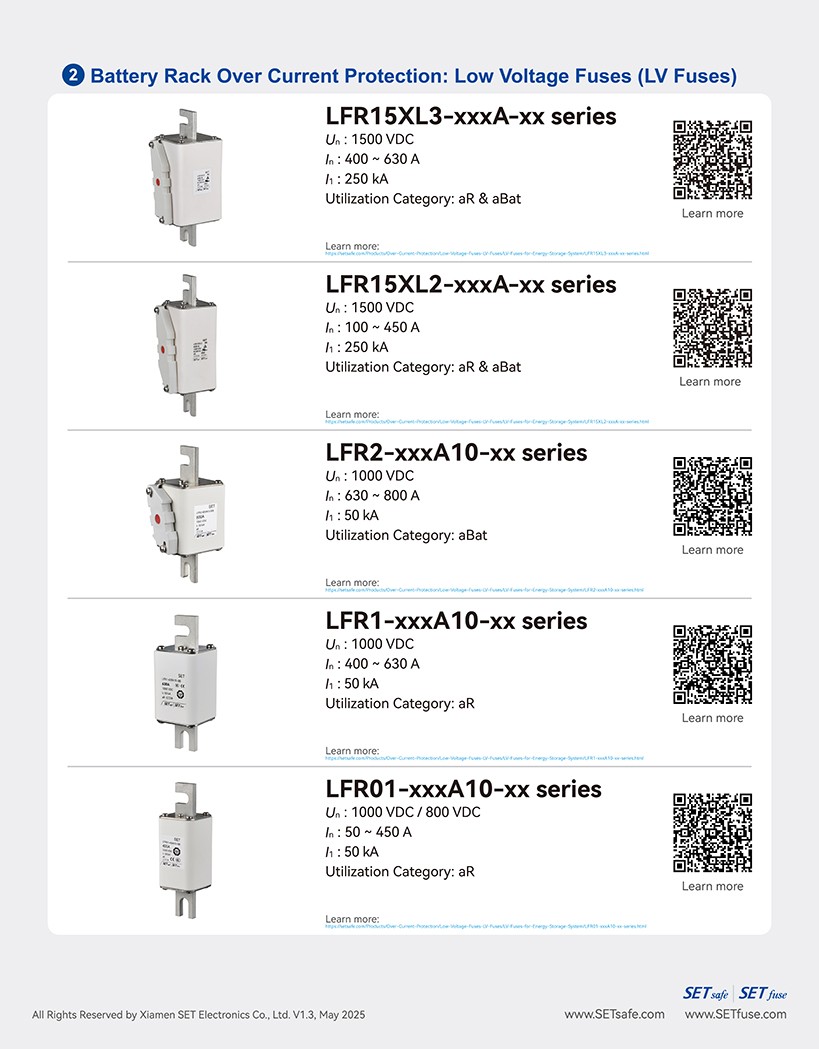
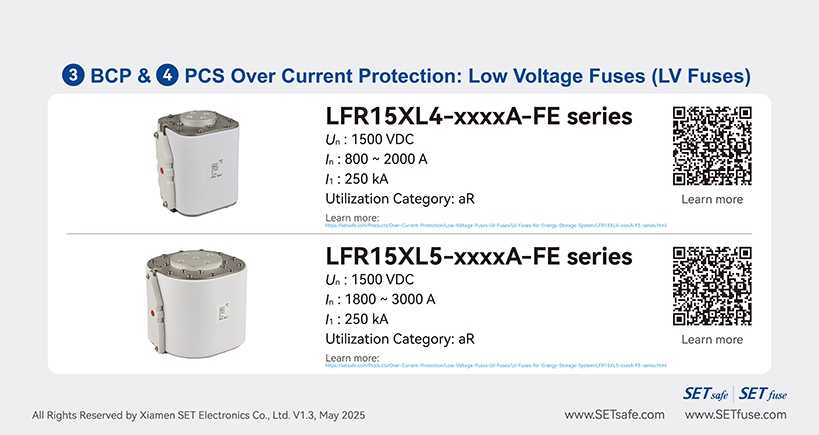
Technical Article (For Reference Only):
The main reasons for short circuits in energy storage systems include the following (brief summary):
Insulation Failure:
Aging, damage, or manufacturing defects in insulation materials leading to contact between positive and negative electrodes.
Internal Battery Defects:
Damaged separators, misaligned electrodes, or impurities causing internal short circuits.
External Physical Damage:
Impact, crushing, or foreign object penetration damaging the battery structure.
Electrical Design Issues:
Loose wiring, worn cables, or improper design.
Overload or Abnormal Operation:
Overcharging, over-discharging, or failure of control systems (e.g., BMS).
Environmental Factors:
High temperature, humidity, lightning strikes, or grid abnormalities leading to short circuits.
The importance of circuit safety protection in energy storage systems primarily stems from the following aspects:
Why It's Important:
Prevent Equipment Damage:
Energy storage systems typically involve high-voltage, high-current battery packs (e.g., lithium batteries). Without effective protection, they can be damaged due to overload, short circuit, or overheating, potentially leading to fire or explosion.
Ensure Personnel Safety:
Circuit faults can cause electric shock, fire, or toxic gas leakage, endangering the safety of operators and the surrounding environment.
Extend System Lifespan:
Safety protection measures effectively prevent abnormal operating conditions (e.g., overcharge, over-discharge), extending the lifespan of batteries and the entire system.
Ensure Stable System Operation:
Energy storage systems are often used in critical scenarios like grid peak shaving and photovoltaic energy storage. Circuit protection prevents system failures, ensuring power supply reliability.
Comply with Regulatory Requirements:
Many countries and regions have strict safety standards for energy storage systems, and comprehensive protection measures are a prerequisite for compliant operation.
Summary:
Circuit safety protection for energy storage systems, through multi-layered hardware and software measures, ensures safe and reliable system operation. These measures work in concert to form a comprehensive protection system, covering electrical, thermal management, and physical safety aspects. In practical applications, the appropriate protection scheme should be selected based on system scale, battery type (e.g., lithium battery, lead-acid battery), and application scenario (e.g., home energy storage, industrial energy storage).
Partner with SETsafe | SETfuse to Transform Technical Challenges into Reliable Solutions
When you encounter technical challenges in selecting circuit protection components or designing system solutions, the professional engineering team at SETsafe | SETfuse is your trusted partner. Specializing in over-temperature, over-current, over-voltage, and active protection technologies, SETsafe | SETfuse offers comprehensive technical expertise and rapid response to meet your needs. Whether you require precise product parameter guidance or comprehensive system-level protection solutions, SETsafe | SETfuse delivers professional, practical, and efficient recommendations and support.
From initial design consultation and solution implementation to post-sales product assurance, we provide end-to-end collaboration, ensuring your project progresses seamlessly and reliably. For any inquiries or requirements, please contact us at: sales@SETfuse.com
Professional Circuit Protection, Supporting You from Concept to Production


































 Rechargeable Battery
Rechargeable Battery Lithium Battery Thermal Runaway
Lithium Battery Thermal Runaway Electric Power Tool
Electric Power Tool New Energy
New Energy PV Power Generation
PV Power Generation Wind Power Generation
Wind Power Generation Energy Storage Batteries
Energy Storage Batteries Energy Storage System (ESS)
Energy Storage System (ESS) Electric Vehicles
Electric Vehicles EV Charging Stations
EV Charging Stations Light Electric Vehicles
Light Electric Vehicles Home Appliances
Home Appliances Small Household Appliances
Small Household Appliances Large Home Appliance
Large Home Appliance Home Appliance Component
Home Appliance Component Kitchen Appliances (Hotplates ...)
Kitchen Appliances (Hotplates ...) Air Fryer
Air Fryer Coffee Machine
Coffee Machine Electric Iron
Electric Iron Smart Toilet
Smart Toilet Personal Digital Products
Personal Digital Products Lifestyle Appliances
Lifestyle Appliances Office Equipment
Office Equipment Walkie Talkie
Walkie Talkie Medical Analysis Instrument
Medical Analysis Instrument Medical Auxiliary Facility
Medical Auxiliary Facility Medical Instrument
Medical Instrument Lighting
Lighting Indoor Lighting
Indoor Lighting Outdoor Streetlight
Outdoor Streetlight Power Supply
Power Supply Power Supply (Power < 20 Watts)
Power Supply (Power < 20 Watts) HVDC in Data Centers
HVDC in Data Centers Power Supply Unit (PSU)
Power Supply Unit (PSU) Battery Backup Unit (BBU)
Battery Backup Unit (BBU) Uninterruptible Power Supply (UPS)
Uninterruptible Power Supply (UPS) Telecommunication
Telecommunication Automotive
Automotive Power Strip
Power Strip Surge Protection Power Strip
Surge Protection Power Strip Security & Protection
Security & Protection Tethered Drone
Tethered Drone Industrial Robot
Industrial Robot Humanoid Robot
Humanoid Robot Service Robot
Service Robot Specialty Robot
Specialty Robot Agricultural Irrigation Equipment
Agricultural Irrigation Equipment Smart Agricultural Greenhouse
Smart Agricultural Greenhouse Rail Transit Facility
Rail Transit Facility Rail-Vehicle
Rail-Vehicle Railway Power Supply
Railway Power Supply Fuel Dispenser
Fuel Dispenser Traffic Control System
Traffic Control System Traffic Signal Light
Traffic Signal Light Commercial Cleaning Equipment
Commercial Cleaning Equipment Delivery Locker (Drone)
Delivery Locker (Drone) Vending Machine
Vending Machine Lightning Protection Components
Lightning Protection Components HVAC Rooftop Systems
HVAC Rooftop Systems Outdoor Electric Wall Mounted Heater
Outdoor Electric Wall Mounted Heater Flag Explain
Flag Explain








































